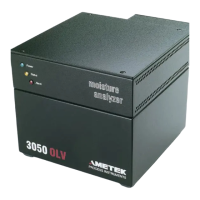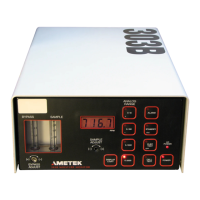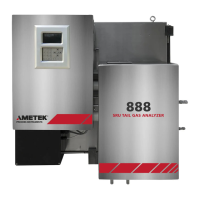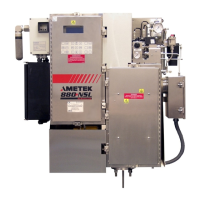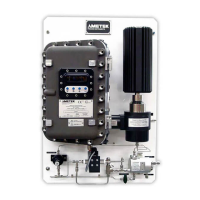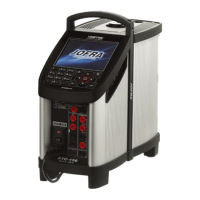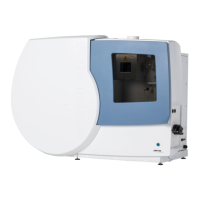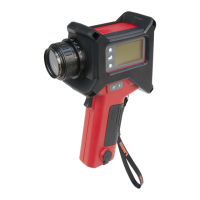INSTALLATION AND START-UP
Incoming sample temperature 0 °C and 100 °C
Optimum input gas temperature 60 °C ± 5 °C
Minimum input pressure 6 PSIG
Maximum pressure 50 PSIG
Wiring 22 gauge twisted/shielded pair
Sample Input Tubing ¼” OD, electropolished 316L VAR SS
Make sure power is o before you begin installation.
Rear Panel Connections:
1. Remove terminal cover to access interface board.
2. Install main process shut-o valve and pressure regulator at sample tap.
Gas Connections:
1. Remove VCR plugs and gaskets from sample inlet tting and exhaust tting and con-
nect sample input tube and exhaust tube. Vent exhaust to vent system.
2. Connect instrument air supply to instrument air tting.
3. Select 120 or 240VAC on voltage selector. Mark operating voltage on rear panel.
Electrical Connections:
1. Make sure the installed power cord has an approved terminator plug per NEC and CEC
regulations.
2. Wire the analyzer per requirements for non-hazardous location per instructions in
Chapter 3 of the manual.
Communications Connections:
1. Connect 4-to-20 mA analog output and alarm/data valid terminals on interface board
to analyzer using metallic signal conduit.
2. Connect the RS-232 or RS-485 serial communications to analyzer. RS-485 connection
shares same cable and metallic signal conduit as analog output and alarm/data valid
contacts.
3. RS-485 Communications: RS-485 terminator switch is turned to “ON,” only if your unit
is a dedicated analyzer or if it is the last analyzer in a chain of multiple analyzers.
Replace all analyzer covers before continuing.
Initial Startup:
1. Open the main shuto valve at the source.
2. Turn on the AC power at the source.
3. Once the sample ow starts, the analyzer will be in normal operating mode. Allow
analyzer to warm up for 45 minutes.
Dry Down:
Allow 5 to 7 days for the analyzer to dry down and stabilize. At end of dry down period,
concentration value on display will be stable and recorded data will level o . Zero alarms
will still be on the display. See Chapter 3 in the manual for more details on dry down and
information on shortening the dry-down process.
Zero Key:
Hold Outputs Enable or Disable
Adjust Ofst/Span Enable or Disable
Zero Zeros the analyzer on demand.
Abort Aborts zero cycle
Alarm Key:
High Limit Enter value in PPMV
Low Limit Enter value in PPMV
Enable Alarm Select enable or disable
Analog Range Key:
Maximum Concentration
Enter moisture concentration equivalent to 20 mA.
Minimum Concentration
Enter moisture concentration equivalent to 4 mA.
Test Con g Key:
Display
Contrast Default is 5
Back Light Default is ON.
Communication
Baud Rate Default is 9600
RS-485 Mode Default is 4-wire
Sample Gas
Select the gas you want to analyze.
Clock
Enter hours using the 24-hour clock.
Zero Schedule
Schedule Type, Day of Week, Day of Month,
Hour and Duration
Production Codes
Production codes for the reference dryer.
System Test
Test Display
Test Keypad
Test Alarms
Test Analog Output
Test Serial Communications
QUICK REFERENCE CARD
Reference Chapter 3 of the 3050 AM Moisture Analyzer manual.
ANALYZER PARAMETERS
Zero Cycle:
Perform a zero cycle a er the dry down.
Press Zero key and then the #8 key (arrow down) until you see “Zero.” Press the Enter key to select.
Zero cycle takes approximately 2 hours. When zero cycle is complete, the analyzer will adjust the zero o set and automatically return to normal sampling.
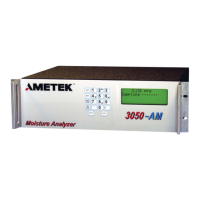
